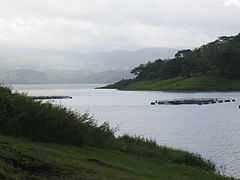Lake Arenal
| Lake Arenal | |
|---|---|
 A view from the southwest side looking across at the north | |
| Coordinates | 10°27′N 84°46′W / 10.45°N 84.77°WCoordinates: 10°27′N 84°46′W / 10.45°N 84.77°W |
| Type | reservoir |
| Basin countries | Costa Rica |
| Average depth | 30-60 m |
Lake Arenal is an artificial lake in Costa Rica, located in the northern highlands of the country. It was enlarged to its present size as a part of a 1979 hydroelectric project by the Costa Rican government to provide electricity to the country.
Geography
Lake Arenal is situated in the northern highlands of Costa Rica, in the provinces of Guanacaste and Alajuela. It is located in the Arenal Tilaran Conservation Area, and is close to the Arenal Volcano and Monteverde cloud forest.
The lake is approximately 30 km long and almost 5 km at its widest point, making it the largest lake in Costa Rica at 85-square-kilometre (33 sq mi). Its depth varies between 30 and 60 meters (100–200 feet) depending on the season.[1]
The town of Arenal was relocated to higher ground when the lake was expanded in 1979. The old towns of Arenal and Tonadora now lie abandoned at the bottom of the lake, with the new town of Arenal existing to the northeast on the lake.
Hydroelectricity
Lake Arenal was tripled in size with the construction of the Arenal dam in 1979, which exists at the eastern end of the lake. This hydroelectric project is hugely important to Costa Rica, initially generating 70% of the country's electricity, now closer to 17%, and was also a driving force behind Costa Rica's green energy policy.[2]
Wildlife
There are primarily two species of fish in Lake Arenal (el lago Arenal), the machaca fish (not to be confused with machaca food) and bass. Notable birds found in the area include the hummingbird, woodpecker, kingfisher, and toucan, whose populations make the lake a popular destination for bird watchers. The rainforest ecosystem that encompasses Lake Arenal is hugely biodiverse, composed of over 2000 species of plants, 120 mammals, and 300 birds, and includes the jaguar, tapir, and quetzal.
Recreation
From November through April the strong, dependable winds attract windsurfers to its western end.[3] Many consider Lake Arenal one of the world's foremost windsurfing areas. Wakeboarding is gaining popularity in Costa Rica, with Lake Arenal being the center of this activity. Fishing (primarily for rainbow bass) and kayaking are also popular recreational activities on this lake. The area surrounding the lake has good hiking, biking, bird watching, and horseback riding opportunities.[4]
Gallery
-
-
hydro-electricity on Lake Arenal.
-
Wind power plant of Tierras Morenas, around Lake Arenal.

References
- ↑ Stater, Adam. "Lake Arenal Depth".
- ↑ Pérez, Carlos (2006-12-13). "Results of the Event" (DOC). Minutes of the Workshop on Adaptation to Climate Change in Costa Rica. San José, Costa Rica: Trofcca Central America. Retrieved 2007-10-02
- ↑ "Lake Arenal Costa Rica Tilawa Windsurf Center - Windsuring Kiteboarding Rentals Lessons". Retrieved 2007-10-02.
- ↑ Stater, Adam. "Lake Arenal Activities".


